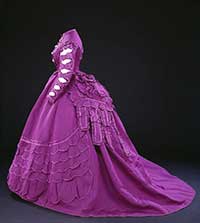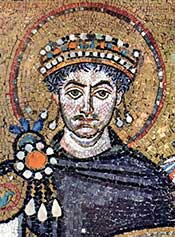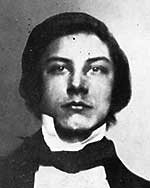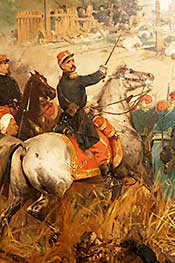How Science and Politics Combined to Create a Color Called Magenta.

What do Emperor Napoleon III, the fight for Italian independence and the birth of the aniline chemical industry have to do with the color magenta? A lot: they are linked in a tale arising from technical and political upheavals that swept Europe in the mid-Nineteenth century.
Magenta, Italy. The color Magenta takes its name from a small city in northern Italy, about 30 kilometers from Milan. The city’s name is typically tied to that of a fourth century Roman Emperor, Maxentius, who had a military camp there.
In the 1850s, Magenta was part of a country called Piedmont; one of the many independent states that then existed on the Italian peninsula. Much of Northern Italy was ruled by the Austrian empire, a situation Italian nationalists were fighting mightily to end.
None of this has anything to do with color; that comes next.

A Revolution in Color. For most of history color choice was dictated by the availability of natural dyes derived from animals, minerals and plants. Colors made from scarce materials became symbols of power. Purple, for example, was the power color in ancient Rome because it came in very small quantities from shellfish that lived near the Phoenician city of Tyre.2 Similarly, Medieval and Renaissance paintings depict the Virgin Mary wearing blue, not based on Biblical or historical evidence, but as a sign of piety. Blue was the costliest pigment since it was made from lapis lazuli, which had to be imported from Afghanistan.4

All that changed literally by accident in 1856 when William Henry Perkin, an eighteen year old chemistry student, decided to spend his Easter vacation experimenting in the lab he had built in his family’s London house. His goal was to produce quinine, which was used to treat malaria in Britain’s tropical colonies, from coal tar, a waste product of gas lighting.
The experiment didn’t work and Perkin was left with messy black goo to clean from his test tubes. As he did, purple residue clung stubbornly to the glass and cotton cleaning rags. But rather than curse the mess, Perkin quickly realized that his failed experiment was a great success, since it had produced exactly the kind of synthetic dye he had unsuccessfully tried to make just a few months earlier.
Purple for the Masses. Perkin patented his process, left school and set himself up in business. He called the color his process produced mauve. It was a great success and won favor with such fashion leaders as Queen Victoria and French Empress Eugenie. Others soon sought to follow in his footsteps.
A French scientist, Verguine, produced a different shade of purple and called it fuchsine for its similarity to the color of fuchsia flowers. British chemists independently developed the same color, but eventually gave it a different name.
Political Revolution. Perkin’s revolution in chemistry came just as Europe was settling down from the tumultuous political uprisings of 1848. In France, the monarchy that had returned with the ouster of Napoleon was replaced by the Second Republic. Napoleon’s nephew, Louis Napoleon, was its president. Barred by term limits from seeking reelection, he staged a coup in 1851 and installed himself as Emperor Napoleon III.

The 1848 uprisings were less successful in Italy as Austrian troops easily defeated the nationalists. Napoleon III’s accession in France, however, would soon turn the tide.
Like his uncle, Napoleon III initiated many reforms; for example, the Paris of stately boulevards we know today was largely created under his direction. And Napoleon’s heir was, of course, expected to be a player on the world stage, so in 1858 he agreed to back Italian nationalists if they were attacked by Austria.
Soon afterward, the Italians provoked an incident and the Austrians attacked. On June 4, 1859, the parties clashed in the town of Magenta. The French and their Italian allies prevailed. The next day cannon thundered in Paris to announce the victory and Napoleon III awarded his commander the title Duke of Magenta. A statue honoring the Duke still stands in Magenta.7
How Magenta Became a Color. Marketers are always looking for ways to keep their products in the public mind, and a time-tested technique is tying them to things people are talking about. The names of famous battles were often used in Victorian England.8 So British dye manufacturers named their new purple dyes Magenta and Solferino, the latter being the name of the battle that ended the Austro-Italian conflict.
Some say the name Magenta was chosen because many of the early sales were to armies that used it for their uniforms,9 others viewed it as an opportunity to make a political statement, but regardless of the reason, sales boomed. British fashion commentators noted the “purple rash” that was sweeping the country in the 1860s,10 while Harvard temporarily had to switch its collegiate color to magenta when the color’s popularity made it impossible to buy crimson.11
Magenta is the “M” in CMYK and is one of the four basic ink colors used in every printing press and computer printer.
* * * * *
The second color named for a battle of Napoleon III’s Italian campaign, Solferino, is largely forgotten. But the legacy of what happened there is not.
Arriving in town on the day of the the battle, Swiss businessman Henry Dunant was shocked by what he saw — over twenty thousand dead and wounded strewn about the battlefield with no real effort being made to assist them. He described his horror in a book, A Memory of Solferino.
Dunant’s efforts led to the founding of the International Red Cross and the Geneva Convention of 1864. In 1901, he shared the first Nobel Peace Prize.12
-----
- Magenta silk dress designed by Vignon. The Empress Eugenie, Napoleon III’s wife, was one of Vignon’s clients. Dress is in the collection of the Victoria and Albert Museum, Item T.118&A to D-1979.
- See Mark Cartwright, Tyrian Purple, in the Ancient History Encyclopedia (July 21, 2016)
- Detail from mosaic at the Basilica of San Vitale in Ravenna, Italy. Image from Wikipedia.
- See, Wikipedia article on Lapis Lazuli and Jean Sorabella, Painting the Life of Christ in Medieval and Renaissance Italy, from the Metropolitan Museum of Art’s Heilbrunn Timeline of Art History (June 2008).
- Perkin took this picture of himself at age 14. Image from the Science History Institute’s on-line biography of William Henry Perkin.
- Detail from Gerolamo Induno, La bataille de Magenta (1861). Image from Wikipedia. Painting is in the collection of the Museo del Risorgimento in Milan.
- History of the Battle of Magenta from Andrew Uffindell, Austro-Sardinian War: Battle of Magenta, Military History (June 1996). Available on-line at HistoryNet web site.
- See Laura Wright, Kiss Me Quick: on the naming of commodities in Britain, 1650 to the First World War, in Merchants of Innovation: The Languages of Traders, pp. 118-19 (2017).
- Kassia St. Clair, The Secret Lives of Color, pp. 167-8, Penguin Books (2016).
- Colour Conversation with Dr Kate Strasdin, fashion historian, at Kettlewell Colours.
- See, R. Leopoldina Torres, The Colorful History of Crimson at Harvard (October 3, 2013), in Index Magazine, Harvard Art Museums.
- See Wikipedia article on Henry Dunant.
This article originally appeared in our free semi-monthly newsletter. To receive future issues, please add your name to the subscription list.

